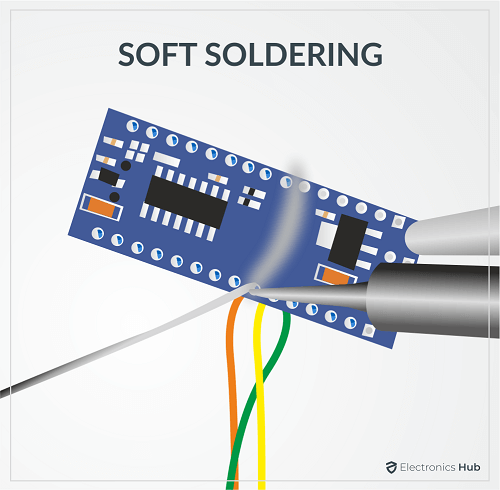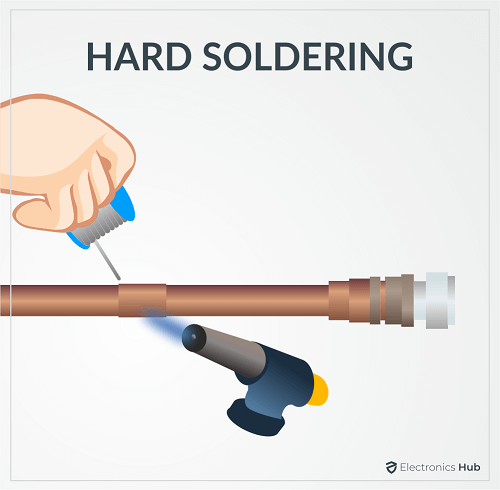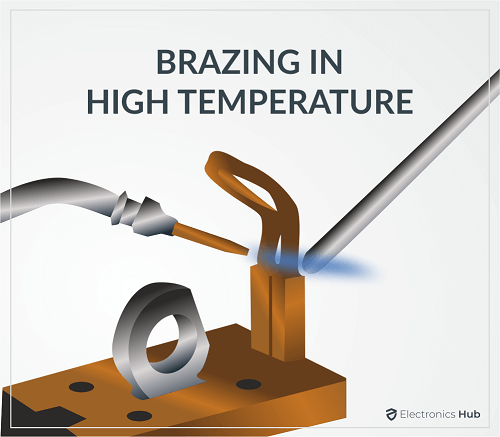Soldering is a process that joins the two types of materials, usually metals. Soldering is a bit tough process for beginners but you can easily learn with practice. Different tools such Soldering Iron, Soldering Station, etc. are very essential for soldering. The solder (which is the filler element) is responsible for creating a good electrical and mechanical joint. The procedure can be used on electronic circuit boards or mechanical areas (plumbing). But a knowledge on different types of Soldering is crucial as there are variations on how you can use it. In this article, we are going to learn more about Soldering in detail.
Outline
ToggleWhat is Soldering?
Soldering is a process of joining two different types of metal by melting solder. It is used for creating a permanent form of a fixed connection between any electronic components. Solder is a metal alloy, which acts as the main filler element to make electrical connection as well as git it the mechanical strength.
Soldering is actually a simple process. You can Solder an electronic component by melting tin-lead solder using a hot soldering iron. Soldering creates permanent connections on circuit boards and copper joints.
The metals that are used in soldering are lead-based solders like brass, copper, and tin. Soldering is necessary to create a connection, which can allow an electric current to flow.
How Does Soldering Work?
Soldering may look like welding but it is very different. In welding, one tries to create a super-strong joint between two pieces of metal by essentially melting and fusing them. In contrast, soldering doesn’t melt the base metals. It uses a filler material (an alloy of tin and lead) with low melting point than the metals. All we have to do is melt the filler (known as solder) and stick the two metals together. In the basic sense, the solder acts as an adhesive that not only holds the two pieces together mechanically but also provides electrical connection.
In plumbing or jewelry, soldering works differently. For instance, plumbers use solder to join copper pipes together in a permanent way, which creates a mechanical robust waterproof joint. In jewelry, it joins fine pieces of metal together to create a new design. The concept is still be the same but the process is very different.
For electrical and electronics soldering, we use soldering iron to melt the solder. But in case of plumbing or jewelry, we use blow torches to melt the solder.
What Filler Metals are Used in Soldering?
In soldering, the most popular filler metals are alloys of tin and lead. Usually, 60% tin and 40% lead is a good composition. But nowadays, lead-free solders are rapidly replacing the lead-based solders. Lead-free solders may contain antimony, brass, bismuth, copper, tin, indium, or silver.
Types of Soldering
There are two main types of soldering or non-fusion joining methods for metals. They are:
- Soft Soldering or Lead Soldering
- Hard Soldering
- Silver Soldering
- Brazing
All these methods use a filler material that melts and fills the gap between two metal pieces. But the parent or main metals do not melt (which is the case in welding).
Soft Soldering
This method is generally used in assembling electronic components on printed circuit boards. Whenever we use the term ‘soldering’, we usually refer to placing electrical and electronic components on circuit board and filling the contacts with molten solder to complete the electrical connection.
The fillers are generally the alloys, which often contain tin and lead, usually in the ratio of 60 to 40. The melting temperature of these solders is in the range of 350 to 450°C. This temperature is significantly less than the melting point of copper, which is the main component of circuit boards. Also, this low melting point distinguishes soft soldering from other soldering techniques.
Tin-lead solder has a long history of use due to its ease of application and reliable results. However, concerns about lead’s toxicity have led to the development and use of lead-free alloys, which comply with health and environmental regulations.
Soldering Irons are responsible for melting the solder. Almost all modern soldering irons are electric with a power rating in the range of 20Watt to 200Watt. The heating element will usually sit inside the soldering and with the help of a tip, it transfers the heat to melt the solder. Speaking of tips, it is the main part of the soldering iron that comes in contact with the components that we want to solder. Soldering Iron Tips come in a variety of shapes, each with a specific set of applications.
Another important ingredient of soldering is flux. The main job of soldering flux is to melt and float over the surface that we want to solder. This helps in cleaning the surface and also prevents it from oxidation during soldering.
Pros
- Relatively low cost
- Materials and equipment are affordable and widely available
- Easy to perform by hobbyists as well as professionals without extensive training
Cons
- Lower strength compared to hard soldering and other techniques
- Joints cannot withstand heavy loads or stress
- Components might fail if exposed to temperatures above the solder’s melting point
Hard Soldering
Principally, Hard Soldering is very similar to Soft Soldering. But the difference lies in the materials on which we use, filler solder element, and the temperature range. Hard Soldering forms a strong connection when compared to soft soldering.
Silver Soldering
As the name suggests, silver soldering uses silver alloys as the filler material. These alloys typically contain silver mixed with copper, zinc, or other metals. The filler material contains anywhere between 2 to 85% of silver, however, 20 to 50% silver composition is more common (due to the cost). This type of soldering is quite common in repairs of stainless steel, copper, and brass.
The composition allows the solder to melt at a relatively low temperature compared to other hard soldering methods, usually between 650 to 800°C. Instead of a soldering iron, both hard soldering techniques use blow torch to melt the filler element.
Silver soldering is very popular in jewelry making, where artisans need precise and strong joints. Additionally, HVAC technicians use silver soldering to connect pipes and components in heating, ventilation, and air conditioning systems
Brazing
Brazing uses brass, copper, or silver as the filler material, with a significantly higher melting point than the other two processes (typically around 900°C or more). The filler metal melts and flows into the joint, creating a strong bond upon cooling. If done properly, brazing can produce almost invisible joints after cleaning up the job.
Similar to other soldering techniques, flux is necessary in brazing to clean the surface from contaminants and prevent oxidation. Borax-based flux, which is usually available in powder form, is the most popular type of flux in brazing.
Brazing serves various applications, including metalwork and aerospace. Metalworkers use brazing to join different metals, creating intricate designs and structures. In the aerospace industry, brazing ensures secure and durable joints in aircraft components. The high strength and temperature resistance of brazed joints make them suitable for these high-stress environments.
Pros
- It provides high-strength joints that withstand heavy loads and stress
- Joints created through hard soldering can endure extreme temperatures without losing integrity
Cons
- The materials and equipment required for hard soldering are more expensive
- Requires skilled technicians to achieve precise and strong joints
Other Soldering Types
Reflow Soldering
Reflow soldering involves heating solder paste to melt and form joints. This method is common in Surface Mount Technology (SMT). Manufacturers use reflow soldering to attach surface-mounted components to printed circuit boards (PCBs). The process is ideal for modern electronics manufacturing to make precise and reliable connections.
Material
The primary equipment is the reflow oven that heats the solder paste to the required temperature, allowing it to melt and form joints. Reflow ovens come in various configurations, including infrared, convection, and vapor phase.
Solder paste is another critical material in reflow soldering. The paste consists of tiny solder particles suspended in a flux medium. This composition allows for easy application and reliable joint formation. Solder paste formulations vary, with lead-free options available to comply with environmental regulations.
Process
First step is to apply solder paste to the PCB. This step typically uses a stencil for precise placement of the paste on the pads. Next, we have to place components onto the PCB. Automated pick-and-place machines position the components accurately on the solder paste. Proper alignment during this step ensures that the components make correct contact with the solder pads.
Finally, the PCB undergoes reflow heating in the reflow oven. The oven follows a controlled temperature profile, heating the solder paste to its melting point. The solder paste then melts, forming secure joints between the components and the PCB. After cooling, the solder solidifies, completing the reflow soldering process.
Applications
Reflow soldering is widely used in the manufacturing of printed circuit boards (PCBs). This method is essential for producing modern electronic devices. Smartphones, computers, and other consumer electronics rely on reflow soldering for their assembly.
Pros
- Automated equipment and controlled heating profiles enable consistent and reliable joints
- Automation reduces labor costs and increases production efficiency, making it suitable for high-volume manufacturing
Cons
- Reflow ovens and pick-and-place machines represent a significant investment for manufacturers
- The process requires careful control to achieve optimal results
Wave Soldering
Wave soldering is a method used for joining through-hole mounted components to printed circuit boards (PCBs). This process involves passing the PCBs over a wave of molten solder.
The molten solder forms a continuous wave, which ensures that all the component leads make contact with the solder simultaneously. This method is especially effective for PCBs with a large number of through-hole components.
Materials
The primary piece of equipment in wave soldering is the wave soldering machine. This machine consists of several sections, each designed to carry out a part of the soldering process. The solder pot within the machine heats and maintains the solder in a molten state, creating the solder wave.
Solder bars provide the material for the solder wave. These bars typically contain a mixture of tin and lead or a lead-free alloy. The machine melts the solder bars, forming the continuous wave needed for the process.
Process
The first step is to apply flux to the PCB. The flux cleans the metal surfaces and promotes better solder adhesion. Next, the PCB undergoes preheating. The preheating stage raises the temperature of the PCB gradually. This step prevents thermal shock when the board contacts the molten solder. Preheating also activates the flux, further preparing the surfaces for soldering.
After preheating, the PCB moves over the solder wave. The wave of molten solder touches the bottom side of the PCB, soldering all the exposed leads and pads simultaneously. This contact forms the solder joints that connect the components to the board.
Finally, the PCB goes through a cooling phase. Cooling solidifies the solder, securing the components in place.
Applications
Wave soldering is widely used in the mass production of electronic assemblies, especially for PCBs with a large number of through-hole components.
Pros
- The process is highly efficient
- It can solder multiple components simultaneously
Cons
- Limited suitability for fine-pitch components
- The process is less effective for surface-mounted components, which have become increasingly common in modern electronics
Laser Soldering
Laser soldering uses a focused laser beam to heat the solder. This method allows for precise control over the soldering process as we can direct the laser beam to very small areas.
We can easily adjust the laser’s intensity and duration for different materials and components. This reduces the risk of thermal damage to sensitive components.
Equipment
Performing laser soldering requires a special system that includes a laser source, optical components, and a control unit. The laser source generates the beam, while the optical components direct and focus it onto the soldering area. The control unit allows the operator to adjust the laser’s parameters, such as power and exposure time, to suit different soldering tasks.
Solder wire or paste provides the filler material for the joints. Solder wire comes in various diameters, while solder paste contains tiny solder particles suspended in a flux medium. The choice between wire and paste depends on the specific application and the components involved. Both materials ensure strong and reliable joints when used with the laser soldering process.
Applications
Laser soldering is very popular in the field of microelectronics for assembling very small and delicate components on PCBs. Additionally, laser soldering is essential in the production of medical devices. These devices often contain sensitive electronics and components that require precise and reliable soldering.
Pros
- The focused laser beam allows for accurate soldering, even on very small components
- Laser soldering minimizes thermal impact i.e., it prevents damage to surrounding components and materials
Cons
- High initial cost
- Achieving optimal results requires precise calibration and control
Frequently Asked Questions
What is the difference between leaded and lead-free soldering?
Leaded solder contains lead as its primary component, while lead-free solder substitutes lead with other metals such as tin, silver, or copper. Leaded solder has been traditionally used due to its lower melting point and ease of use. However, due to environmental and health concerns, lead-free solder has become more common, especially in consumer electronics.
Which soldering technique is best for beginners?
For beginners, hand soldering through-hole components is often the best technique to start with. It requires minimal equipment and can be easily practiced at home. A basic soldering iron, solder wire, flux, and some practice boards are all that’s needed to get started. As skills improve, beginners can gradually explore surface mount soldering.
Can soldering be done without a soldering iron?
While a soldering iron is the most common tool for soldering, there are alternative methods for joining metal components. One such method is using a soldering gun, which operates similarly to a soldering iron but with a built-in trigger mechanism for easier handling.
What are some common soldering defects?
Common soldering defects include cold joints, solder bridges, solder balls, and insufficient solder. Cold joints occur when the solder does not flow properly, resulting in a weak connection. Solder bridges occur when solder connects adjacent pads or traces, causing short circuits. Solder balls are small balls of solder that can form on the PCB surface during soldering, potentially causing electrical shorts. Insufficient solder results in weak connections that may fail over time.
Conclusion
Different types of soldering cater to various applications and requirements. Soldering technology continues to evolve, driven by advancements in electronics and material science. One significant trend is the shift towards lead-free soldering. Emerging technologies like additive manufacturing and 3D printing are influencing soldering methods. Integrating these technologies with traditional soldering processes opens new possibilities for creating special and customized electronic assemblies.




